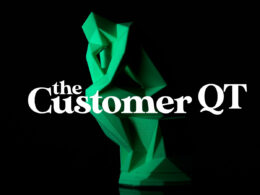In this hybrid retail environment, the human talent of retail employees is even more critical to delivering seamless customer experiences.
Employee data is one of the richest and least-operationalized pieces of information in retail. Most definitions of retail emphasize products and service, but the truth is that retail has always been a people business. United States retail businesses employ more than one in four jobs nationwide, making retail the nation’s largest private sector employer. Will that change as more and more people are shopping online? No.
by Miriam Molino Sánchez
Most people agree the omnichannel hybrid model is going to be the de facto model for the retail industry, combining brick-and-mortar and online retail with social media. However, taking a multichannel approach to sales and the customer experience doesn’t mean retail employees will be replaced by technology or somehow lose importance. Despite the perception that automation and digitalization are a threat to the world’s workers, companies embracing the technology frontier are actually creating jobs. We’re seeing cases where technology takes an important – even predominant – role in store operations, such as Amazon GO.
Many retailers are implementing new ways to interact with customers and retail teams, with or without technology at the core. Lululemon, the Canadian sports retailer, offers complimentary yoga classes. Beauty retailer Sephora provides interactive livestreams, encouraging customers to chat with beauty and wellness experts.
In this hybrid retail environment, the human talent of retail employees is even more critical to delivering seamless customer experiences. Retailers that can connect their personnel and retail stores to digital commerce in real time can significantly increase conversion rates. And although technology is crucial, employees still matter the most.
Why are retailers struggling?
Retail talent encompasses a huge variety of skills, from the most traditional in grocery (fishmongers, butchers) to new digital skills (AI, ML, Cloud, Data Science, IoT). It also includes retail-specific knowledge like customer service and support and, of course, product expertise in all its different variations. Right now, retail talent is not at its best. The Bureau of Labor Statistics (BLS) reported that 4.3 million people left their jobs in August 2021 alone, and retail suffered the second highest number of quits in August (over 720,000), beaten out only by the food service and accommodation industry.
This situation seems like the perfect storm: Customer expectations are rising and retailers are heavily investing in technologies, but the necessary talent to exploit those expectations and accelerate ROI is scarce. People are quitting. These staffing issues are already having an impact on retailers’ finances – more than two-thirds are struggling to meet sales targets due to labor problems.
Retailers are struggling to find a solution. Many have launched programs to improve recruiting, secure key people and increase engagement. But competitive pressure, increasing costs and margin constraints leave only limited scope for exceptional measures. Nevertheless, there are five pragmatic and relatively easy-to-implement steps retailers can take to complement, reinforce and expand their talent development efforts:
- Identify critical hard and soft skills of key employees through in-person interviews or surveys. Establishing and managing a centralized skills repository enables retailers to identify key employees with scarce skills to establish preventive programs; identify skills gaps in a specific geographic area, store, or process to guide training programs; classify employees to be retrained in new required areas; categorize the skills HR managers should focus on to streamline recruiting processes.
- Establish a governance mechanism to govern this skills repository, who updates it, when and how often. Link it to staff development programs, recognition schemes or promotions. This linkage is essential in a context where continuous learning and retraining is a must for all employees. It has also the positive effect of nurturing and developing talent for the retail organization and the entire retail ecosystem.
- Create a data hub where employees (or managers) can enter and update their availability and geographic flexibility so that workforce scheduling can be planned accordingly. The ability of retailers to schedule their staff to match service requirements with employee preferences will be critical to reducing churn, as scheduling, along with other factors, is one of the main reasons employees quit. Better employee experiences are critical to increasing engagement and reducing employee attrition.
- Link employee data to other core retail dimensions, such as product or location, to understand who the experts are for specific products, who the most skilled employees are for specific store services or store activities. Retail stores are transforming or expanding their role by turning into experience centers, moving into dark stores or offering new services. With this evolution, it’s essential to know who can perform certain store activities and what his/her availability is.
- Enable skills data to strengthen omni-channel execution by:
- Encouraging store experts to participate in digital channels during valley time to support customers through chat or WhatsApp, live events or in-person remote coaching sessions. Each retail sub-sector needs to find the right path. Grocers, for example, could host live commerce sessions with fresh products in their stores so their customers order them online and pick them up in-store. This type of action creates a sense of recognition for in-store staff, expands the variety of work tasks and encourages learning new digital capabilities.
- Strengthening the implementation of digital channels in the store and appointing store-level champions who can train or coach the rest of the staff.
- Decentralizing certain customer service or customer support activities to specific branches using the knowledge of branch staff.
This activation of skills shouldn’t add to the workload – it should engage employees in new activities that support the transformation of the business. The idea is to broaden the scope of responsibility and pave the way for acquisition of new skills. Of course, all these measures must be coordinated with career development programs.
Capturing, maintaining and using employee data to drive flexibility, engagement and participation in digital transformation can help develop retail talent – reducing the risks of burnout and termination.
Miriam Molino Sánchez is Head of Global Retail Practice at Stibo Systems.
Photo by Xianjuan HU on Unsplash












